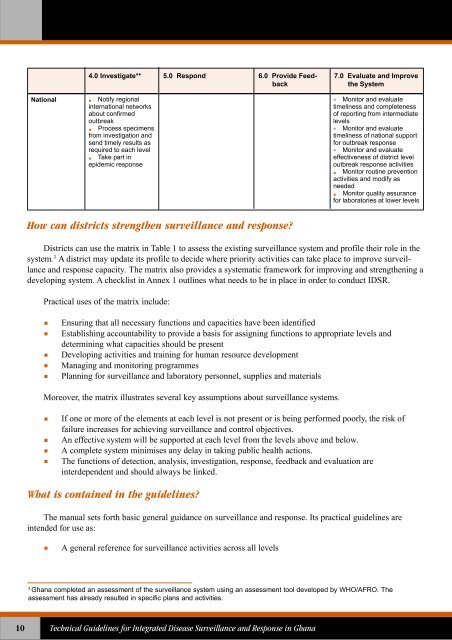Technical Guidelines for Integrated Disease Surveillance ... - PHRplus
Technical Guidelines for Integrated Disease Surveillance ... - PHRplus
Technical Guidelines for Integrated Disease Surveillance ... - PHRplus
You also want an ePaper? Increase the reach of your titles
YUMPU automatically turns print PDFs into web optimized ePapers that Google loves.
National4.0 Investigate** 5.0 Respond 6.0 Provide FeedbackNotify regionalinternational networksabout confirmedoutbreakProcess specimensfrom investigation andsend timely results asrequired to each levelTake part inepidemic response7.0 Evaluate and Improvethe SystemMonitor and evaluatetimeliness and completenessof reporting from intermediatelevelsMonitor and evaluatetimeliness of national support<strong>for</strong> outbreak responseMonitor and evaluateeffectiveness of district leveloutbreak response activitiesMonitor routine preventionactivities and modify asneededMonitor quality assurance<strong>for</strong> laboratories at lower levelsHow can districts strengthen surveillance and response?Districts can use the matrix in Table 1 to assess the existing surveillance system and profile their role in thesystem. 3 A district may update its profile to decide where priority activities can take place to improve surveillanceand response capacity. The matrix also provides a systematic framework <strong>for</strong> improving and strengthening adeveloping system. A checklist in Annex 1 outlines what needs to be in place in order to conduct IDSR.Practical uses of the matrix include:Ensuring that all necessary functions and capacities have been identifiedEstablishing accountability to provide a basis <strong>for</strong> assigning functions to appropriate levels anddetermining what capacities should be presentDeveloping activities and training <strong>for</strong> human resource developmentManaging and monitoring programmesPlanning <strong>for</strong> surveillance and laboratory personnel, supplies and materialsMoreover, the matrix illustrates several key assumptions about surveillance systems.If one or more of the elements at each level is not present or is being per<strong>for</strong>med poorly, the risk offailure increases <strong>for</strong> achieving surveillance and control objectives.An effective system will be supported at each level from the levels above and below.A complete system minimises any delay in taking public health actions.The functions of detection, analysis, investigation, response, feedback and evaluation areinterdependent and should always be linked.What is contained in the guidelines?The manual sets <strong>for</strong>th basic general guidance on surveillance and response. Its practical guidelines areintended <strong>for</strong> use as:A general reference <strong>for</strong> surveillance activities across all levels3Ghana completed an assessment of the surveillance system using an assessment tool developed by WHO/AFRO. Theassessment has already resulted in specific plans and activities.10<strong>Technical</strong> <strong>Guidelines</strong> <strong>for</strong> <strong>Integrated</strong> <strong>Disease</strong> <strong>Surveillance</strong> and Response in Ghana















